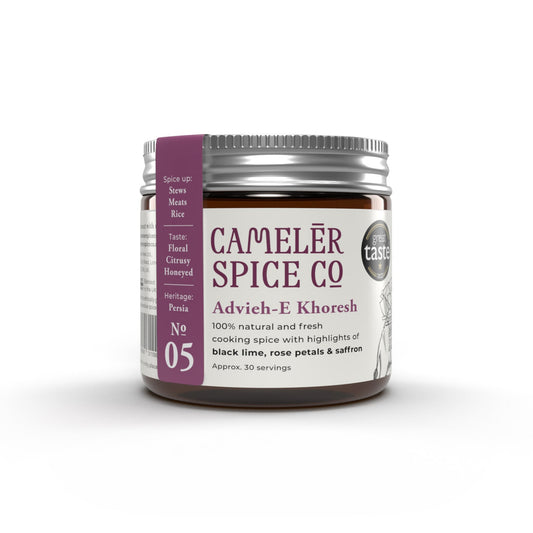
Collection: Saffron
(Also known as Red Gold)
What does saffron taste like?
Grassy, Bitter and Honeyed, Saffron is the most expensive spice in the world. It has a warm, musky smell like freshly cut hay, with a mild metallic note. Saffron imparts an intense yellow colour to a dish while emitting strong perfume and a delicate flavour. A little pinch goes a long way.
Why choosing saffron from the right country matters.
Saffron comes from the dried yellow stigmas of the saffron crocus flower. Always look for vibrant red strands, as duller red or brown colours may indicate staleness. Although doubts remain on its origin, evidence suggests that Saffron originated from Iran, which is currently the world’s largest producer of saffron. Greece holds the second position and also makes a claim as its possible birthplace. Trade and use of saffron date back thousands of years, with early recording beginning in the 7th Century AD.
Countries like Azerbaijan have increased saffron production as of 2020. Sales to countries such as the United Arab Emirates accounted for the largest share of Azerbaijan's saffron exports since the beginning of 2020. Spanish saffron is considered very good but Afghan saffron is considered exceptional in terms of quality having won 3 stars from the international taste institute in Brussels for several years. Iran is reported to produce approximately 85% of the world's saffron, according to the UN Food and Agriculture Organization.
What flavours go with saffron?
- Almond
- Anise
- Cardamom
- Cauliflower
- Lemon
- Lime
- Nutmeg
- Orange
- Potato
- Rhubarb
- Rose
Saffron is still grown in the UK and traditionally it was grown in Cornwall where it was a key ingredient in the Cornish Saffron cake alongside nutmeg. Our Persian 6th Century BC Advieh-E Khoresh is bursting with saffron notes. This Great Taste award-winning spice mix is a demonstration of how saffron is a cornerstone alongside the other flavours of black lime, cardamom and rose petals.
What are the health benefits of saffron?
Part of the Iris family (Crocus sativus), saffron is an excellent source of minerals and is often used in tea. Rich in antioxidants such as crocin, crocetin, safranal, and kaempferol. These compounds may provide a variety of health benefits, including mood improvement, depression treatment, cancer-fighting properties, and support for a healthy nervous system. Additionally, saffron has been associated with other potential health benefits like reducing PMS symptoms, boosting libido, aiding in weight management, and enhancing overall immune function.
What are interesting facts about saffron?
- Just 6,000 flowers and 12 hours of labour will give you 30g or 1oz of saffron. As a rule of thumb, you should avoid ground saffron as it is hard to know if it is genuine. It is worth reflecting on the question as to "Why is saffron so expensive?"
- Saffron has been around since the Bronze Age, prized for millenniums. Historical hieroglyphical evidence suggests that Cleopatra bathed in saffron-scented mare's milk.
- The Essex town of Saffron Walden gets its name from the spice that grew there. Saffron is still grown in the UK to this day in Essex and Devon, where it is said to have a sweeter honey-like taste.
- La Mancha in Spain has EU-protected status for its prized saffron.
- Saffron's modern name derives from the Arabic for yellow.
- Saffron has long been used to dye textiles. Buddhist priests have long worn yellow robes dyed with saffron.
What is the chief flavour profile of saffron?
Picrocrocin: (musky, earthy, warm and bitter) The picrocrocin compound and the safranal compound are both unique to saffron. Their qualities and their potency mean less is more. The bitterness of saffron complements and balances other potent compounds that come from caraway, paprika and black pepper to balance the overall complete taste. Saffron dissolves better in water than oil, allowing time for the flavour to escape and elevate.
Saffron nutritional facts
For a detailed breakdown of the nutritional values of this product, including calorie content, macronutrients, and other key details, please refer to the attached nutritional information sheet. This information is also available on our jars, with allergens highlighted in bold
Shop Spices With Saffron
-
Advieh-E Khoresh
Regular price £8.95 GBPRegular priceUnit price / per


